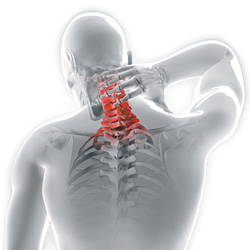"It's exciting to see the chiropractic community take up the work of the task force this way," commented Dr. Sheilah Hogg-Johnson, IWH senior scientist and task force member. "The Neck Pain Evidence Summary provides a way for health-care professionals to review the evidence easily in their practice, and if they need further information, they can refer to the full research papers."
 The evidence summary features background on the task force, a "new conceptual model of neck pain" developed by the task force, general messages, treatment messages, a comprehensive grading system (including symptoms/signs and initial assessment by grade), and several figures and tables that illustrate appropriate assessment and treatment of neck pain patients. Key messages from several of these sections are summarized as follows:
The evidence summary features background on the task force, a "new conceptual model of neck pain" developed by the task force, general messages, treatment messages, a comprehensive grading system (including symptoms/signs and initial assessment by grade), and several figures and tables that illustrate appropriate assessment and treatment of neck pain patients. Key messages from several of these sections are summarized as follows:
General Messages
- While most people who suffer neck pain continue usual activities, up to 11 percent of adults are limited in activity performance and up to 1 percent suffer disabling pain.
- Multiple factors usually contribute to neck pain, including physical and mental health, work, and daily activities. Most cases of neck pain do not reflect serious illness/disease; diagnostic imaging tests (X-rays, CT, MRI, etc.) are only required in a minority of cases, and routine imaging does not enhance understanding of pain causality.
- For patients presenting with traumatic acute neck injuries, the Canadian Cervical Spine Rule (CCR) and the National Emergency X-Radiography Utilization Study (NEXUS) Low Risk Criteria (both of which appear as appendices in the evidence summary) are recommended for identifying patients who do not require imaging.
- Vertebrobasilar (VBA) dissection/stroke is "extremely rare" and is no more likely to occur following a chiropractic visit than following a visit to a medical doctor. Pre-existing VBA dissection is a risk factor for stroke, but there is "no practical way to screen neck pain and headache patients for this problem."
Treatment Messages
- There is no "best treatment"for neck pain. A combination of treatments may be necessary, and even then, benefits may be "modest or short-lived." Longer treatment time is not associated with more substantial improvements, and all treatment should be based on the patient's grade of neck pain (see general grading descriptions below).
- The patient's informed treatment preferences and attitude regarding risk should dictate treatment. Practitioners should provide the patient with an informed choice of effective options and involve them in decision-making.
- Most neck pain is of the Grade I (no signs of major pathology and no or little interference with daily activities) or Grade II (no signs of major pathology, but interference with daily activities) variety.
- When treating non-traumatic neck pain, effective treatment options include manipulation, mobilization, supervised exercises, manual therapy plus exercise, acupuncture, low-level laser therapy and analgesics. Effective treatments for acute traumatic neck pain are educational videos, mobilization, exercises and mobilization plus exercise.
- Certain treatment options are not likely to be effective for Grade I or Grade II neck pain. For non-traumatic neck pain: advice from health-care providers on its own, collars, passive modalities (heat therapy, ultrasound, transcutaneous electrical nerve stimulation [TENS], electrical nerve stimulation), exercise instruction and botulinum toxin A; for acute traumatic neck pain: pamphlet/neck booklet alone, passive treatments (heat, cold, diathermy, hydrotherapy, ultrasound, TENS), referral to fitness or rehabilitation program, frequent early health-care service, methylprednisolone, exercise instruction, botulinum toxin A, and corticosteroid injections; for non-acute neck pain: passive treatments (heat, cold, diathermy, hydrotherapy, ultrasound, TENS), and corticocosteroid injections.
- Grade III neck pain (neck pain with neurological signs and symptoms) merits extreme caution in terms of treatment. According to the evidence summary, "There is little research on non-surgical interventions for Grade III neck pain. Consider epidural corticosteroid injections for temporary relief of radiculopathy. Consider surgery in the presence of serious pathology or persistent radiculopathy."And regarding Grade IV (major structural pathology) neck pain, the summary notes: "Aggressive surgical treatment of many of these conditions is generally accepted as effective and often strongly advised. Refer to literature of specific pathological conditions."
As noted, the above represents only a small portion of the information featured in the Neck Pain Evidence Summary. A complete copy of the summary is available for free download from the IWH Web site: www.iwh.on.ca/neck-pain-evidence-summary.
For background on the BJD Task Force on Neck Pain and Its Associated Disorders, read "Neck Pain Task Force Releases Findings" (Feb. 26, 2008) and "Task Force Results Explained to Media, Health Professionals" (May 20, 2008).




